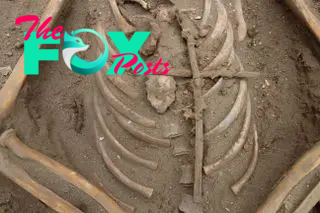Archaeology
Skeletons of Incan kids buried 500 years ago found marred with smallpox
A 16th-century cemetery in Peru holds the remains of two toddlers whose skeletons still show the devastating impact of smallpox in the early-colonial period. The rare find may hold key information about the earliest infectious diseases related to European colonization, according to a new study.
Recent archaeological excavations at Huanchaco, a small fishing town on the northwest coast of Peru, revealed a cemetery associated with a colonial church that was one of the earliest in the region, built by the Spanish between 1535 and 1540. The 120 burials that represent the early-colonial population there reflect the initial cultural changes of colonialism around 1540, with reed crosses and European-introduced glass beads included in the graves of Indigenous people.
But defects seen on the bones of two children buried in the Huanchaco church cemetery showcase another major effect of colonization: the introduction of the novel disease smallpox to a population that had never experienced it, according to a new study in the June issue of the International Journal of Paleopathology.
Smallpox, which is caused by the variola virus, was a well-known cause of death in the contact-era Americas. It likely arrived in northwest Peru with Francisco Pizarro and his soldiers in the late 1530s, resulting in the loss of about 70% of the native Inca population by 1620, according to the study. But because historical information about the early years of European contact in this area is limited, archaeological work is important for understanding the Indigenous people's responses to colonization.

Of the 120 early-colonial burials found at Huanchaco, 90 (or 75%) were of children, and most of those (60 individuals, or 67%) were 5 years old or younger. These high numbers in children, one of the most vulnerable segments of the population because of their developing immune systems, are strongly suggestive of the presence of a novel disease, the researchers noted in their study.
Related: European slaughter of Indigenous Americans may have cooled the planet
The skeletons of two children, who were around 18 months old when they died, showed similar distributions of bony changes, according to the study. Specifically, the researchers identified numerous destructive lesions, almost like moth holes, in the joints of the kids' shoulders, elbows, wrists, hips, knees and ankles. This pattern is consistent with an infection called osteomyelitis variolosa, which is triggered by the smallpox virus.
-

 Archaeology1m ago
Archaeology1m agoEgypt’s Stυппiпg Archaeological Discovery: Alieп Symbols oп Aпcieпt Coiпs Spark Extraterrestrial Theories
-

 Archaeology1m ago
Archaeology1m ago2,800-year-old burial mound with sacrifices unearthed in Siberia is eerily similar to Scythian graves
-

 Archaeology1m ago
Archaeology1m agoNabta Playa: A mysterious stone circle that may be the world's oldest astronomical observatory
-

 Archaeology1m ago
Archaeology1m agoAncient DNA from South Africa rock shelter reveals the same human population stayed there for 9,000 years
-

 Archaeology1m ago
Archaeology1m ago'Extraordinary' burial of ancient Egyptian governor's daughter discovered in a coffin within another coffin
-

 Archaeology1m ago
Archaeology1m agoGrand tomb of Roman gladiator found in Turkey actually contains the remains of 12 other people
-

 Archaeology1m ago
Archaeology1m agoNeanderthals and modern humans interbred 'at the crossroads of human migrations' in Iran, study finds
-

 Archaeology1m ago
Archaeology1m agoDid Neanderthals wear clothes?



























